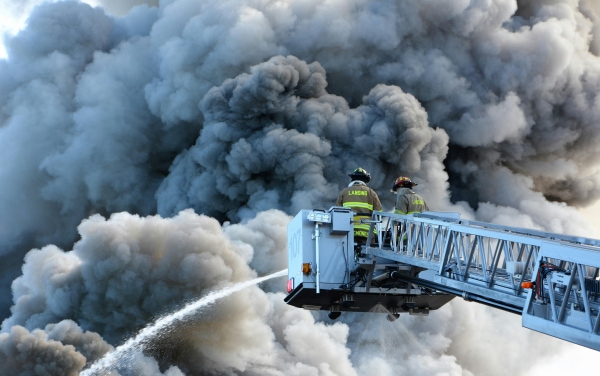Fentanyl's Occupational Risk to Fire, Police, & EMS
Protecting our first responder populations is essential to maintaining national security, social well-being, and citizen care. Every time a first responder dons their uniform, they face occupational hazards, exposure to danger, and potential for disaster. Most do so willingly to protect and serve their communities. First responders need better care and support. As a society, we can aim to reduce stigma and barriers to mental health treatment while enhancing awareness of the internal struggles associated with their role. We owe it to those who sacrifice their lives daily for us.
Occupational Hazards
First responders are exposed to several occupational hazards, including threats to personal safety, long work hours, frequent shifts, poor sleep, and physical hardship (Heavey et al., 2015). These can have detrimental effects on their overall well-being, their relationships, and community service. Since 2013, with the proliferation of illicitly manufactured drugs, there has been an increasing risk of fentanyl exposure for first responders among their communities (Thompson et al., 2021). Death by overdose and poisoning has increased significantly (by 14.37% among all 38 states from 2019 to 2020) and continues to rise (Thompson et al., 2021). First responders are increasingly encountering drug-related emergencies with opioids and other substances, heightening their risk of fentanyl exposure (Thompson et al., 2021).
However, research is limited on the direct effects of fentanyl exposure in first responder populations. Many healthcare organizations report a low prevalence of fentanyl exposure and a high potential for nocebo effects among fire, police, and EMS personnel (Winograd et al., 2020). Medical experts deny fentanyl’s exposure effects via nasal or skin-to-skin contact, which has been debunked. Fentanyl contact can occur via inhalation, ingestion, mucosal, or percutaneous methods (Thompson et al., 2021). However, exposure may be more evident among used needles.
It is important to consider the implications of these messages, limited research, education and how harmful they are to these populations. First responders need proper access to Personal Protective Equipment (PPE) and education about recognizing the signs of fentanyl exposure, poisoning, and overdose for the safety of their team members and the betterment of those affected by fentanyl usage (Winograd et al., 2020) Educational efforts could help First responders to respond to and recognize dangerous substance use, such as illicit fentanyl (Winograd et al., 2020). The fear of fentanyl exposure, persistent stressors, and minimal mental health resources together can increase occupational distress among these populations (Winograd et al., 2020).
Mental Health and Alcohol Use
First responders are at an increased risk for developing mental disorders, such as posttraumatic stress disorder, depression, and anxiety (Substance Abuse and Mental Health Services Administration; SAMHSA, 2018). Approximately 30% of first responders will experience a behavioral health condition during their careers (Abbot et al., 2015), with firefighters and law enforcement facing a higher risk of suicidal ideation and completion compared to the general population (Stanley et al., 2016; Badge of Life, 2016). Prior military service was an additional risk factor for adverse mental health outcomes, including suicidality and alcohol/substance abuse problems (Carson et al., 2023). As substance use increases, the risk of suicide increases drastically (Kaplan et al., 2014).
Alcohol overuse is prevalent among first responders, often used as a coping mechanism to alleviate symptoms of trauma exposure (Ballenger et al., 2010; Regehr et al., 2000). It can be used as avoidance coping to alleviate negative symptoms of recurrent trauma and disaster exposure (Dixon et al., 2009; Irizar et al., 2021). Haddock et al. (2012) found that career firefighters drank heavily about 10 days a month, and 40% of volunteers averaged more than 3 drinks during binging episodes. Similarly, women firefighters also reported binge drinking and drinking while intoxicated in the last month (Haddock et al., 2017). Of the 16.5% of women meeting the criteria for problematic drinking, they were 2.5 times more likely to be diagnosed with PTSD or a depressive disorder.
Law enforcement officers are also at risk for problematic drinking, as some have reported drinking weekly (Ballenger et al., 2010). Heavy drinking off-duty is common, particularly among law enforcement officers, leading to increased risks of hazardous alcohol use and substance dependence disorders (Ballenger et al., 2010). Moreover, it may also be more socially acceptable among their peers, as most officers spend 75% of their free time with coworkers (Ranes, 2015). According to Ballenger et al. (2010), 11% of male and 16% of female officers had engaged in risky drinking behaviors in the last week. More interestingly, women officers reported higher drinking behaviors, which was not reflective of the general population. 3.7% of women officers had consumed more than 28 drinks in the past week, with 7.8% of men and women meeting a substance use or dependence disorder (Ballenger et al., 2010). Similarly, officers with increased disaster exposure met the criteria for hazardous alcohol use (Heavey et al., 2015). Therefore, it is important to consider the impact of repetitive traumatic disaster exposure among these populations and its effects on mental well-being and substance coping.
How Can We Help?
You might be wondering or asking yourself, how can I help these systemic problems among first responders? Reducing stigma around mental health and substance use treatments is the first step in addressing systemic issues among first responders. The general population experiences significant stigma around substance use, and it is more common among fire, police, and EMS workers. Increased awareness and the normalization of substance effects can prevent harm, educate, and support individuals in need of assistance. Connection to community organizations, like the XFoundation, can collaborate with first responders to develop training programs and raise awareness about the dangers of fentanyl use, ultimately enhancing community safety and supporting the well-being of essential workers. It is essential to create awareness and explore ways to maintain the betterment of our communities, with those who serve and protect.
**Please note: This post is for educational purposes only. This post does not constitute medical advice and is not intended as a substitute for professional medical advice, diagnosis, or treatment, and readers are advised to consult with a qualified healthcare professional for any medical concerns or conditions. The views expressed may not reflect those of all healthcare professionals
References
Abbott, C., Barber, E., Burke, B., Harvey, J., Newland, C., Rose, M., & Young, A. (2015, January 1). What’s killing our medics? Reviving Responders. http://www.revivingresponders.com/originalpaper/
Badge of Life. (2016). A study of police suicide 2008–2016. In Saint Peters College. Saint Peters College. https://policesuicide.spcollege.edu/assets/BadgeofLife_July2016.pdf
Ballenger, J. F., Best, S. R., Metzler, T. J., Wasserman, D. A., Mohr, D. C., Liberman, A., Delucchi, K., Weiss, D. S., Fagan, J. A., Waldrop, A. E., & Marmar, C. R. (2010). Patterns and predictors of alcohol use in male and female urban police officers. The American Journal on Addictions, 20(1), 21–29. https://doi.org/10.1111/j.1521-0391.2010.00092.x
Carson, L. M., Marsh, S. M., Brown, M. M., Elkins, K. L., & Tiesman, H. M. (2023). An analysis of suicides among first responders: Findings from the national violent death reporting system, 2015–2017. Journal of Safety Research, 85(1), 361–370. https://doi.org/10.1016/j.jsr.2023.04.003
Dixon, L. J., Leen-Feldner, E. W., Ham, L. S., Feldner, M. T., & Lewis, S. F. (2009). Alcohol use motives among traumatic event-exposed, treatment-seeking adolescents: Associations with posttraumatic stress. Addictive Behaviors, 34(12), 1065–1068. https://doi.org/10.1016/j.addbeh.2009.06.008
Haddock, C. K., Jahnke, S. A., Poston, W. S. C., Jitnarin, N., Kaipust, C. M., Tuley, B., & Hyder, M. L. (2012). Alcohol use among firefighters in the central united states. Occupational Medicine, 62(8), 661–664. https://doi.org/10.1093/occmed/kqs162
Haddock, C. K., Poston, W. S. C., Jahnke, S. A., & Jitnarin, N. (2017). Alcohol use and problem drinking among women firefighters. Women’s Health Issues, 27(6), 632–638. https://doi.org/10.1016/j.whi.2017.07.003
Heavey, S. C., Homish, G. G., Andrew, M. E., McCanlies, E., Mnatsakanova, A., Violanti, J. M., & Burchfiel, C. M. (2015). Law Enforcement Officers Involvement Level in Hurricane Katrina and Alcohol Use. International Journal of Emergency Mental Health and Human Resilience, 17(1), 1–16. https://doi.org/10.4172/1522-4821.1000157
Irizar, P., Puddephatt, J.-A., Gage, S. H., Fallon, V., & Goodwin, L. (2021). The prevalence of hazardous and harmful alcohol use across trauma-exposed occupations: A meta-analysis and meta-regression. Drug and Alcohol Dependence, 226(1), 1–20. https://doi.org/10.1016/j.drugalcdep.2021.108858
Kaplan, M. S., Huguet, N., McFarland, B. H., Caetano, R., Conner, K. R., Giesbrecht, N., & Nolte, K. B. (2014). Use of alcohol before suicide in the united states. Annals of Epidemiology, 24(8), 588–592. https://doi.org/10.1016/j.annepidem.2014.05.008
Ranes, B. (2015, November 1). Alcohol abuse among police officers. Www.hazeldenbettyford.org; The Hazelden Betty Ford Foundation. https://www.hazeldenbettyford.org/research-studies/addiction-research/alcohol-abuse-police#:~:text=Police%20officers%20are%20a%20unique
Regehr, C., Hill, J., & Glancy, G. D. (2000). Individual predictors of traumatic reactions in firefighters. The Journal of Nervous and Mental Disease, 188(6), 333–339. https://doi.org/10.1097/00005053-200006000-00003
Stanley, I. H., Hom, M. A., & Joiner, T. E. (2016). A systematic review of suicidal thoughts and behaviors among police officers, firefighters, emts, and paramedics. Clinical Psychology Review, 44(44), 25–44. https://doi.org/10.1016/j.cpr.2015.12.002
Substance Abuse and Mental Health Services Administration. (2018). First responders: Behavioral health concerns, emergency response, and trauma. In SAMHSA (pp. 1–15). SAMHSA. https://www.samhsa.gov/sites/default/files/dtac/supplementalresearchbulletin-firstresponders-may2018.pdf
Thompson, R. A., Sanderson, W. T., Westneat, S., Bunn, T., Lavender, A., Tran, A., Holsinger, C., Flammia, D., Zhang, L., & He, Y. (2021). Perceptions of opioid and other illicit drug exposure reported among first responders in the southeast, 2017 to 2018. Health Science Reports, 4(3). https://doi.org/10.1002/hsr2.335
Winograd, R. P., Phillips, S., Wood, C. A., Green, L., Costerison, B., Goulka, J., & Beletsky, L. (2020). Training to reduce emergency responders’ perceived overdose risk from contact with fentanyl: Early evidence of success. Harm Reduction Journal, 17(1). https://doi.org/10.1186/s12954-020-00402-2


